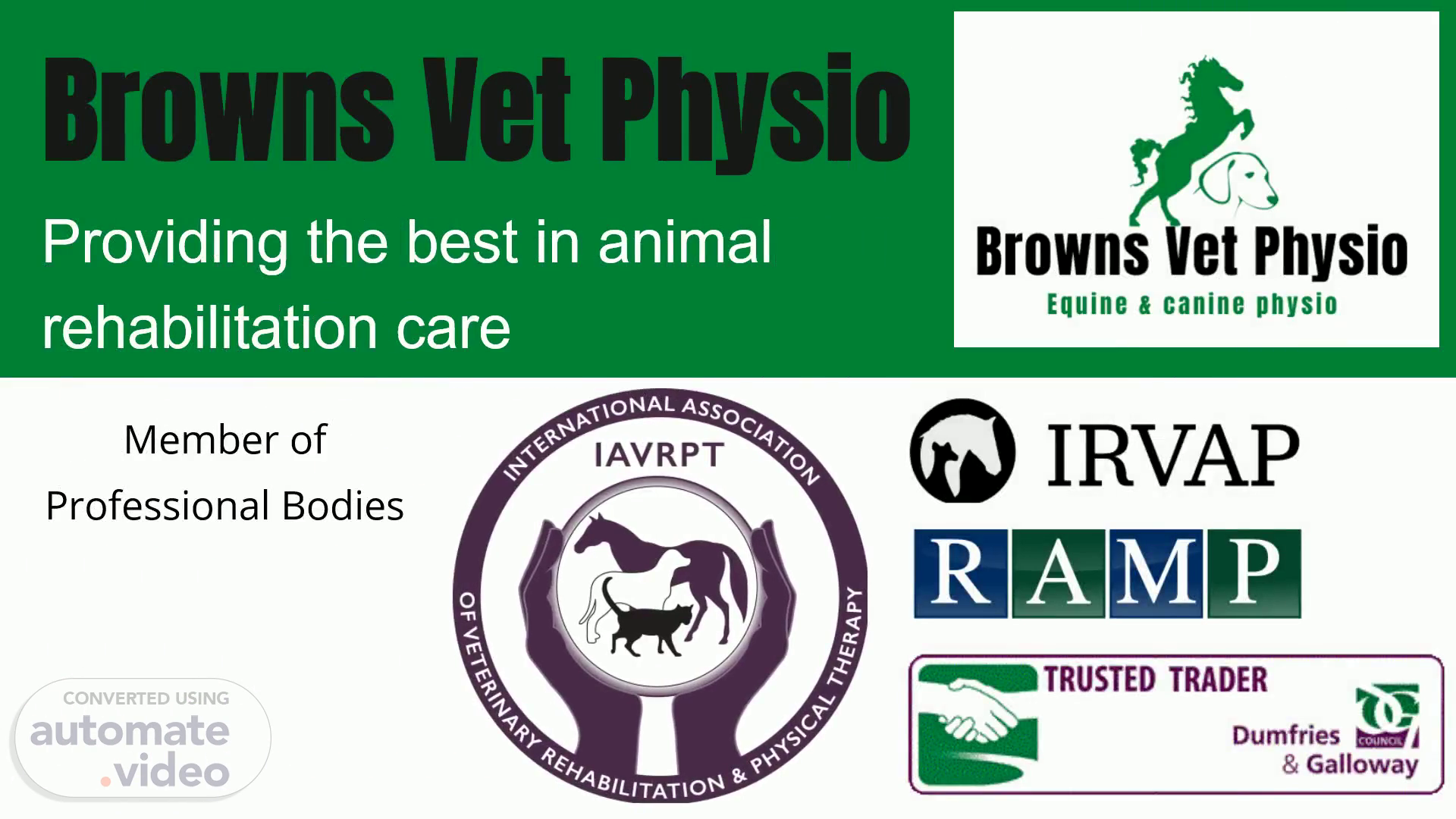Scene 1 (0s)
Browns Vet Physio Providing the best in animal rehabilitation care.
Scene 2 (10s)
NEW Canine Physio clinic, Brampton next door to Northwest K9 Hydrotherapy Purpose built rehabilitation facility on your doorstep, no need to have an in house physio taking up a valuable room at your practice..
Scene 3 (26s)
About Me Melanie Brown, BSc (Hons), Vet Phys, MIRVAP (VP), MIAVRPT, MRAMP.
Scene 4 (55s)
Professional Memberships. Institute of Registered Veterinary & Animal Physiotherapists ( IRVAP ) Veterinary physiotherapist m embers are required to have the following: Holder of an accredited university qualification at level 6 – 7. Fully insured and work within the UK legislation requiring a veterinary referral to commence treatment. Have high standards in professionalism and clinical proficiency are assured through our accredited registration process Undertake 25 hours of CPD every year.
Scene 5 (1m 14s)
Professional Memberships. Register of Animal Musculoskeletal Practitioners ( RAMP ).
Scene 6 (1m 38s)
Professional Memberships. International Association Veterinary Rehabilitation and Physio Therapy (IAVRPT).
Scene 7 (1m 57s)
Veterinary Economics magazine states ' Physical therapy as one of the top 5 areas that practices should add to increase revenue '.
Scene 8 (2m 13s)
What do we do Provide manual therapy, which includes massage, trigger point release, myofascial release, mobilisation, PROM, stretching Use electrotherapies, e.g. TENS, NMES, Pulsed Electromagnetic Field therapy (PEMF), ultrasound, red light therapy with clinical reasoning Assess gait, stance and behavioural issues that are commonly associated with pain and common issues, such as hip dysplasia Provide your client with information, research and suggestions on improving home environment Tailor make an exercise plan for their pet and continually reassess and change the plan.
Scene 9 (2m 38s)
Research.
Scene 10 (2m 44s)
Why is rehabilitation important? 'if you don't lose it, you lose it' For example, without rehab, a dog can lose 1/3 of muscle mass, in the rear limb, after cruciate ligament rupture surgery, and it may take over one year to regain lost muscle And in some cases, recovery may not occur, not to mention the compensation factors that occur. ..
Scene 11 (3m 4s)
After CCL surgery WHAT HAPPENS. These physiological changes happen after CCL surgery and shows the effects on the musculoskeletal and central nervous system.
Scene 12 (3m 19s)
Effect of Physical Rehabilitation on Stifle Extension.
Scene 13 (3m 39s)
Dogs that have undergone surgery for fractures ligament injur ies neurological conditions WILL HAVE.
Scene 14 (4m 0s)
Benefits of physical rehabilitation. Increased speed of recovery Positive psychological effects for the pet & owner Improved performance and quality of movement Increased strength and endurance Improved biomechanics and flexibility Reduced pain Non invasive approach Minimal complications Prevention of future injury through owner/trainer education Owner can be involved in the process of rehab with home exercise programme.
Scene 15 (4m 17s)
1. Increased speed of recovery Studies have shown that patients who undertook physical rehabilitation stood and also walked within half the time compared to the group who underwent the traditional management groups..
Scene 16 (5m 17s)
7. Non invasive The use of physical therapy is non invasive and this can help with managing cases that do not wish to proceed with surgical intervention..
Scene 17 (5m 53s)
Conditions in dogs that can benefit from physical therapy.
Scene 18 (6m 11s)
& m any more conditions. Degenerative Myelopathy the use of physical therapy can prolong life expectency with higher quality of life**.
Scene 19 (6m 34s)
Customer Testimonials. 'Mel had a great empathy with my dog. Her treatment facility is well equipped, she is very knowledgeable, explained the physio program and developed a specific regime for me to follow at home with him. Mel also delivered on her promises and promptly followed up with information. I wouldn't hesitate to recommend Browns Veterinary Physiotherapy. Jillian & Tom.
Scene 20 (7m 40s)
Other Benefits. Educate the owner on home environment and adaptations that can help prevent further injury Form a bond with owner and animal free from fear of a clinic environment Recommendation of pharmaceuticals/return visits to the surgery Owner can be involved in the process of rehab with home exercise programme Can help to identify musculoskeletal issues early Value for money - time spent with client can be upto 1 hour for a set fee and lots of information can be gained from client.
Scene 21 (8m 2s)
Summary. How physio can help your patients. 01. Potential to improve the outcome of surgical (and nonsurgical) conditions with physical rehabilitations.
